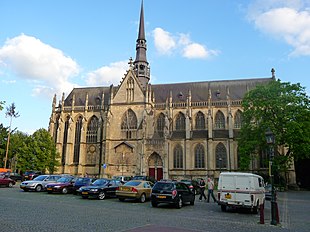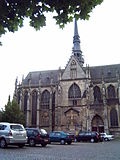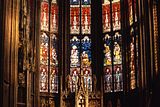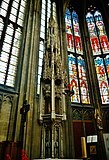Basilica of the Holy Sacrament
The Basilica of the Holy Sacrament ( Dutch Basiliek van het H. Sacrament ), St. Bartholomew's Basilica or Basilica of Meerssen is a Roman Catholic church in Meerssen in the Dutch-Limburg region . The parish church is dedicated to the Holy Sacrament and the Apostle Bartolomew . It was on June 16, 1938 by Pope Pius XI. raised to a minor basilica . The church is an example of the Maas Gothic and is considered the pinnacle of this style in the Netherlands . The building has been a Rijksmonument since 1967 .
history
In Meerssen there was a palace in the early Middle Ages . Some of the delegations that signed the Treaty of Meerssen in 870 were housed here . The Palatine Chapel was on the site of today's basilica. In 968 Queen Gerberga of West Franconia gave the Palatinate to the Benedictines of Reims, who set up a provost's office. Shortly after 1100 the church was converted into a Romanesque church. The miracle of the sacrament is said to have taken place in this church in 1222. During the conversion , the celebrating priest discovered that he had forgotten to add wine and water to the chalice. When the host was broken, water and blood flowed from it into the chalice. The chalice of blood was shown to the many pilgrims who attended the church from that moment on. The church had to be enlarged for the flow of pilgrims, around 1318 a Gothic nave with three bays was built.

The Gothic choir and the transept were created during a subsequent building campaign from 1334 to the end of the century under the direction of Provost Jean de Beaufort. Choir and nave were separated by a choir screen. In 1465 the church was set on fire by mercenaries of the Lord of Borgharen, resulting in a second sacramental miracle. A young farmer from the hamlet of Raar saw the fire while plowing, hurried to the church and pulled the host out of the fire unharmed. When he returned to the field, it was found that an angel had plowed the field. During the rebuilding of the church after this fire, the flying buttresses were added and the rich, late Gothic north portal was built to display the relics of the Blessed Sacrament .
The Sacraments Tower was built around 1500 to keep the Holy Eucharist and the relics of the first miracle. In 1574 the west tower was set on fire by state troops. The remains collapsed in a storm in 1649. In 1612 the provost's office passed to the Augustinians of Eaucourt . In 1633 Meerssen became Dutch and after unsuccessful protests by the provost, the church became a simultaneous church for Catholics and Protestants in 1663 . The church was again badly damaged by a storm in 1749. During the repair work, the tower could not be rebuilt by the municipality of Meerssen due to lack of funds.
After the arrival of the French, the provost's office was dissolved in 1795 and the church was closed from 1798 to 1802. The church then became a parish church, after which the presbytery was lowered and the choir screen was torn down. In 1836 the Meerssen Protestants received their own church, the Leopoldskerkje, which ended the Simultaneum. The church was radically restored from 1879 to 1882, including placing the neo-Gothic turret on the crossing and renewing the ribbed vaults inside. During the restoration of the choir in the years 1895–1901, the missing tracery were put back in place, as were the balustrades with battlements along the eaves. The north portal was restored in the years 1910-12. During a subsequent restoration in 1936/38, the nave was extended by three bays on the west side by the architect Jos Cuypers and the neo-Gothic roof turret was replaced by a more sober variant. A restoration of the exterior took place in 1986-88. Among other things, part of the battlements was renewed. The last restoration of the stained glass windows and the Sacraments took place in 2012/15.
Both sacramental miracles are celebrated annually during the Meerssen Octave . The opening takes place on the Thursday after Trinity Sunday, followed by eight days of processions from various parishes of the former deanery to the basilica. The procession on Corpus Christi Sunday alternates between Meerssen and Raar.
description
Outside
The Meerssen basilica consists of a nave with three Gothic and three neo-Gothic bays, a transept from the 14th century and an equally old choir. The neo-Gothic sacristy , which was built on the south side of the choir, dates from 1878. There are some stone crosses from the 17th century. On the north-east side of the church is the striking neo-Gothic burial chapel of the Maastricht manufacturer family Regout from 1869.
Inside
Almost all of the church furnishings were designed by Pierre Cuypers . The main altar dates from 1897, the communion bench from 1898 and a large statue of the Sacred Heart made of Italian marble from 1910. The pulpit from 1911 is a design by Johannes Kayser. All of the church furniture and a number of statues mentioned are made in the studio of Jan W. Ramakers en Zonen in Geleen. The stained glass windows date from the late 19th century and were made in the workshop of F. Nicolas en Sons. In the 1950s, Jos ten Horn designed a series of windows for the church made by Studio Mesterom. Charles Eyck made the window on the choir loft in 1958 .
Next to the neo-Gothic triumphal gate from 1905 is a group of calvaries from the 16th century. On a side altar there is a late Gothic statue of St. Barbara from around 1500. A special feature is the late Gothic sacraments tower (Theoteca) on the side of the presbytery. Of the heavily restored sculpture, only the Groups of Moons, the Last Supper, and the Melchizedek Sacrifice were originally from the 16th century. The restoration was carried out by the Ramakers company. Pierre Cuypers had a plaster representation of the sacrament house made, which could be seen in the Rijksmuseum in Amsterdam for many years .
Organs of the basilica
There was an organ in the Meerssen church as early as the 16th century. When the church was refurbished in 1804, the organ was moved from the transept to the west side of the church. When the church was expanded in 1938, the historic organ was torn down. Parts of the old organ were used in the new two-motor electro-pneumatic organ made by the company Vermeulen. In 1980 the old pipework was used again in the construction of the choir organ that Heinz-Wilbrand-Orgelbau from Übach-Palenberg built. In 1990 the Vermeulen organ was demolished and on October 25, 1991 the large Wilbrand organ was put into use.
Chimes and chimes
There are two bell bottoms in the roof turret. In 1944 the chimes and the new carillon were stolen by the German occupiers. After the liberation, three new bells and 29 play bells were installed. In 2007 a hand-operated chime was installed and the carillon with 5 bells was expanded to 34 pieces (2 octaves).
Web links
- Basiliek van het Heilig Sacrament In: kerkgebouwen-in-limburg.nl (Dutch)
Individual evidence
- ^ Basiliek van het Heilig Sacrament on gcatholic.org
- ↑ Register of monuments
Coordinates: 50 ° 53 ′ 1.6 ″ N , 5 ° 45 ′ 18.2 ″ E








